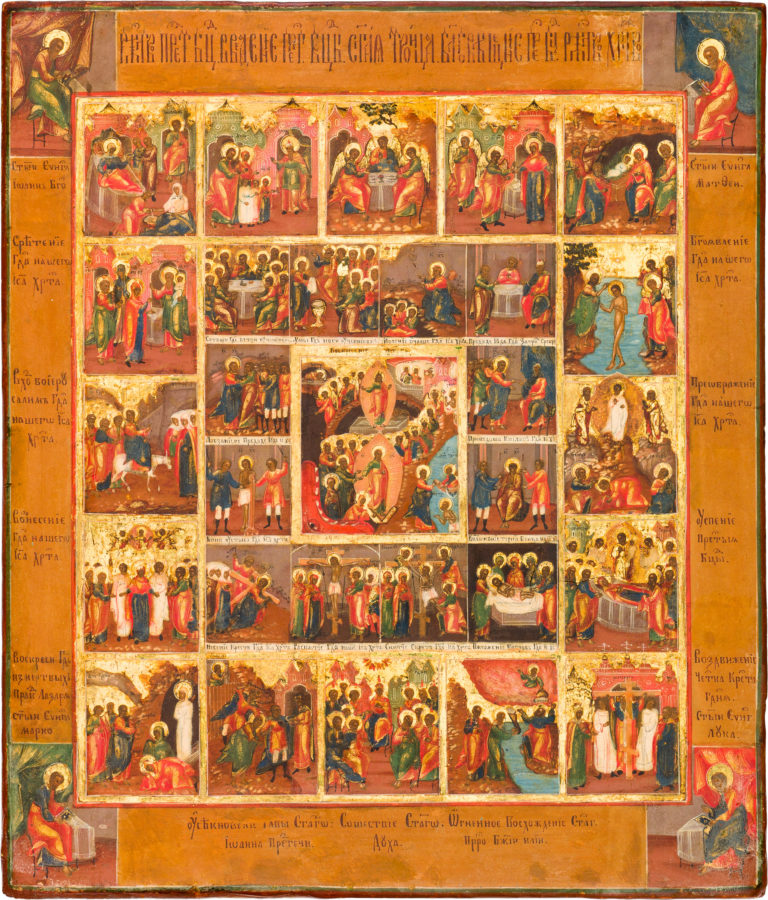The Resurrection—the Descent into Hell, with the Passions of Christ, the Four Evangelists, and Church Feasts in 28 Border Scenes
Antique Russian icon. Around the middle of the 19th century. con-painting centers of the Vladimir region (possibly Palekh).
Size: 31 х 27 х 2.2 cm
Wood (one whole panel), two incut profiled support boards, a shallow incut centerpiece, underlying layer of canvas is not visible, gesso, tempera, gold.
The author’s paintwork is in an overall good condition, with only slight chafing of the paint in places and insignificant restoration tonings on the borders.
Contact us

The Resurrection—the Descent into Hell, with the Passions of Christ, the Four Evangelists, and Church Feasts in 28 Border Scenes
Diagram of the border scenes:
The Festive cycle:
- The Nativity of the Mother of God;
- The Entrance of the Mother of God into the Temple;
- The Old Testament Trinity;
- The Annunciation;
- The Nativity of Christ (The Adoration of the Magi);
- Candlemas (The Meeting of Christ in the Temple);
- The Theophany (The Baptism of Christ);
- The Entrance into Jerusalem;
- The Transfiguration;
- The Ascension;
- The Dormition of the Mother of God;
- The Raising of Lazarus;
- The Beheading of John the Baptist;
- Pentecost (The Descent of the Holy Spirit on the Apostles);
- The Fiery Ascent of the Prophet Elias;
- The Pokrov (Feast of the Protective Veil of the Mother of God).
The Passion cycle:
- The Last Supper;
- The Washing of the Feet;
- The Prayer in Gethsemane;
- Judas receives the 30 pieces of silver;
- The Betrayal of Judas and the Arrest of Christ;
- The Bringing of Christ before Pilate;
- The Flagellation of Christ;
- The Crown of Thorns;
- The Carrying of the Cross;
- The Crucifixion;
- The Taking Down from the Cross;
- The Entombment of Christ.
- The Evangelist John the Theologian;
- The Evangelist Matthew;
- The Evangelist Mark;
- The Evangelist Luke.
The given antique Russian icon belongs to a widespread type of Eastern Orthodox icons called “full-cycle icons” (“polnitsy” in Russian), which represents quite complex compositions with the Twelve Great and the Minor Feasts of the Church brought together around the “Resurrection – The Harrowing of Hades” scene. The universality of the composition leads to the increasing popularity of such hand-painted Orthodox icons among all Russian social classes. One of the main production centers of these religious icon paintings was the village of Palekh in the Vladimir region. Even though holy icons painted there were created in large numbers, they were still known for the high-level artistry, the miniature painting style, and the diversity of various scenes. Thus, except for the cycle of the Twelve Great and the Minor Church Feasts, the given antique icon is also supplemented by another scene – the Passion cycle – which forms one more ring around the centerpiece and really creates the impression of the full liturgical year.
The border scenes bear chronological depictions of the Gospel narrative and the Great Feasts that show the symbolic meaning of Christ’s sacrifice. The cycle begins with the Nativity of the Mother of God, which inaugurates the liturgical year, and ends with the Elevation of the Holy Cross. The iconography of the border scenes is traditional and follows samples known in the Russian icon art in the 15th-17th centuries. However, in some scenes, the artist uses more complex variations. Thus, the “Nativity of the Mother of God” scene includes two women bearing gifts and entering Joachim’s house while in the Annunciation, we see the additional depiction of the Archangel Gabriel standing before the house of Joseph. The “Nativity of Christ” scene is increasingly complex, with the “Adoration of the Magi” in the foreground. Some iconographic details, such as those noted in the “Annunciation” scene, became immensely popular in Old Believer Art. The lower tier of border scenes includes the “Fiery Ascent of the Prophet Elias” and the “Elevation of the Holy Cross,” honoring two of Palekh’s churches. The corners of the hand-painted icon bear the depictions of the Four Evangelists.
The given antique Russian icon belongs to the archaic movement of the 19th-century Russian icon art and represents a stylization based on the Old Russian iconography, in particularly, of the Stroganov school. This movement was predominately developed in the Russian icon-painting villages of Vladimir, famous for the mass production of such religious icons. Local production was especially popular among the Old Believers but also quickly won recognition among the adherents of the official Church.